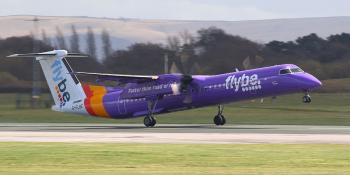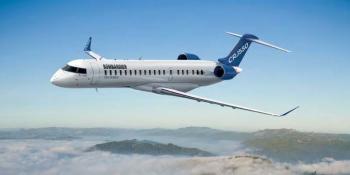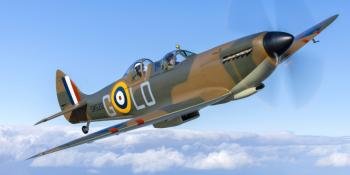De Havilland Aircraft of Canada purchased the Dash 8 in mid-2019. Seven months on, Mark Broadbent reports on the company’s management plans for this enduring turboprop airliner

The Dash 8 turboprop airliner family has now been around for the best part of 40 years, initially with the DHC-8-100/-200/-300 variants first developed in the 1980s and latterly in its current production Dash 8-400 guise.
Last year was a momentous one for the programme, as Bombardier Aerospace sold off the aircraft and the associated De Havilland Aircraft brand to Longview Aviation Capital Corporation. The new owner in turn set up De Havilland Aircraft of Canada (DHC) to manage production of the Dash 8-400, previously marketed as the Bombardier Q400, and ongoing support for in-service aircraft.
How might the new owner develop the Dash 8-400? What future does it envisage for the aircraft?
A fresh start
Bombardier Aerospace’s decision to sell the Dash 8 was part of a much wider restructuring to tackle huge losses and debts. This process also saw the C Series (now A220) divested to Airbus and deals agreed to sell the CRJ regional jet to Mitsubishi Aircraft and some of the aerostructures business – including the Belfast factory that builds the A220’s all-composite wing – to Spirit AeroSystems.
The Victoria, British Columbia-based Longview previously acquired the DHC-6 Twin Otter, type certificates for the DHC-1 through to the DHC-7, and the former Canadair CL-215, CL-215T and CL-415 firefighting aircraft from Bombardier. All these programmes are now managed by the company’s Viking Aircraft unit.
The first firm order for the new ownership came from Air Tanzania, already a Dash 8-400 operator, which signed up for three more aircraft in October 2019. At the Dubai Airshow the following month DHC announced a slew of new business. The lessor Palma Aviation Holdings ordered 20 aircraft and a letter of intent (LOI) for six examples came from Aeroflot subsidiary Aurora Airlines.The government of Ghana signed a LOI for six to equip the country’s proposed new national airline, while the lessor ACIA Aero Capital and the Egyptian company Elin Group each ordered three.
All these orders, totalling 41 aircraft, provided a timely fillip for the new owner given the turboprop aircraft market’s typical ups and downs.

Dash developments
Asked by AIR International about its plans for the Dash 8-400, a DHC spokesperson said: “We will continue to invest in product improvements.For example, we are off ering a design weight increase that would give our customers the potential to carry even greater payloads.
The company did not provide any specifics on the performance increase or when it might be available. The Dash 8-400’s off icial type certificate shows the aircraft’s maximum ramp and taxi weight is 34,700lb (15,740kg)and maximum take-off weight is 34,500lb (15,649kg).
At the 2019 Paris Air Show, DHC announced it would off er ultralightweight TiSeat E2 seats from interiors specialist Expliseat as an optional feature for Dash 8-400 aircraft and as a retrofit for in-service aircraft. The titanium and carbon fibre seats weigh 14lb (6. 5kg) each, and according to DHC provide a total weight saving of between 300 and 1,000lb (136-453kg) per aircraft depending on its configuration and a saving of up to 1% in fuel.
What further product development are possible? In the early 2010s, encouraged by a fresh wave of orders at the time, Bombardier and rival ATR, which produces the Dash 8-400’s direct competitor, the ATR 72-600, investigated developing larger variants of their aircraft with 100 seats.
For Bombardier the concept did not proceed because of its full development plate with the-then C Series, while disagreements between ATR co-owners Leonardo and Airbus meant the company dropped the idea in 2018.
Interestingly, however, when AIR International asked DHC about future development options for the Dash 8-400, the company did not expressly rule out looking again at a 100-seater, or a lowercapacity derivative.
The company said various options for “stretching or shrinking” the aircraft were “under evaluation” as were further ways to enhance eff iciency and reduce the aircraft’s environmental footprint through engine improvements.

An evolved aircraft
Any future developments would build on the modernisation carried out by Bombardier in the decade or so before it sold the programme, which mean today’s Dash 8-400 has much improved capabilities from the original aircraft launched in 1995.
Customers can choose different cabin configurations. The Dash 8-400 was initially designed for up to 78 seats, but continued evolution meant 80-82 seats became standard. Under the Q400 NextGen initiative, which also included a strengthened landing gear, Bombardier developed a new 86-seat option.
This denser arrangement, achieved by removing the 91cu ft (2. 57m3) forward baggage bay, provides a per-seat fuel burn advantage of up to 8% and a seat cost advantage of 20% (based on a 300 nautical miles/550km sector) compared to the ATR, the manufacturer claimed. There is slightly less space, however, with the seats pitched at 29in (73. 6cm) compared to the standard 30in (76. 2cm) with 82 seats. The Thai low-cost airline Nok Air was the first customer for the 86-seat option.
An even higher-capacity 90-seat option was subsequently launched, making the Dash 8-400 the highest-capacity turboprop on the market, with the seats again pitched at 29in (73. 6cm). The Indian airline SpiceJet was the initial operator of this layout in 2018.
Bombardier also developed a 67-seat ‘dual-class’ option, which has seven business-class seats (at 36in/91. 4cm pitch) and 60 economy (at 30in/76. 2cm pitch). Air Canada (for its Jazz operation), Air Côte d’Ivoire, Ethiopian Airlines and WestJet (for its Encore unit) have ordered this layout. There is a combi option, giving operators a mix of seats and cargo storage.
Aside from different interior configurations, another area of development was new operational flight planning practices to cut fuel burn. Time between airframe maintenance checks was also increased, with intervals pushed out to 800 flight hours for A-checks and 8,000 hours for C-checks.

Turboprop attributes
All the different configuration options developed in recent years are off ered by DHC, which acknowledges Bombardier’s work developing the Dash 8 over the years. It told AIR International the previous owner had invested more than $300m in the aircraft over ten years before selling it.
The improvements extended to introducing many new state-of-the-art technologies to the advanced Thales flight deck, one of which is a localiser performance with vertical guidance system.
Using GPS information augmented by data from geostationary satellites, this technology guides an aircraft on vertical and horizontal axes without requiring support from a ground station. Crews can fly precision approaches with minimums of up to 200ft (60m), ideal for flying into airports unequipped with an instrument landing system – exactly the sort of destinations a turboprop like the Dash 8-400 is designed to serve.
A separate advanced system is coupled vertical navigation. This uses the aircraft’s navigation calculator in the flight management system to better define descent and approach trajectories, ensuring the autopilot commands the aircraft to follow a specified vertical profile.
The Dash 8-400 also uses required navigation performance-authorisation required (RNP-AR), which is designed to let pilots fly a route to an accuracy of within 0. mile (0. 16km). As well as improved precision, RNP-AR off ers increased monitoring of aircraft performance combined with onboard navigation alerts, and it can be used to help manage traffic flows at heavily congested airports and anti-noise procedures.
Other avionics and flight deck enhancements designed to maximise safety are a satellite-based augmentation system, an enhanced ground proximity warning system and a head-up guidance system. There is automatic dependent surveillance-broadcast out and electronic flight bag compatibility.
Maximising productivity
In its marketing DHC says the combination of all these advanced avionics, a 99. 5% dispatch reliability rate and the longer time between maintenance intervals means the Dash, “spends more time in the air and less time in repair, providing an extra 270 days of flying before the next C-check [heavy maintenance]".
The company claims the Dash 8-400 is “the most productive turboprop” Just like the previous owner, it highlights performance as a competitive advantage, saying the aircraft: “is nimble enough for a steep approach, yet tough enough to land on unpaved runways. It’s the only turboprop in its class certified for high altitude airports".

DHC claims the aircraft flies 30% faster and 40% further than the rival ATR which, it says, “allows our customers to add more flights to their schedule” The two passenger cabin doors and separate catering and cargo doors boost productivity by helping operators quickly turn an aircraft around, the company believes.
It adds: “Due to its short take-off and landing capabilities and efficient regional operations, it comes equipped with more seats, more legroom, more cargo and offers [its operators] more flights per day.
Another positive, DHC says, is an active noise and vibration suppression system to produce a quieter cabin.Large windows to maximise natural light and LED lighting in the ceiling are other features. Passengers can access content on their personal devices via an optional in-flight entertainment system.
Emerging and existing markets
De Havilland Aircraft of Canada predict continued growth in the turboprop aircraft market, telling AIR International: “Although DHC has not published our own market forecast, several credible industry forecasts reach a consensus that there is demand for approximately 2,700-3,000 large commercial turboprop deliveries in the next 20 years.
The company envisages demand from a geographically diverse customer base, too, saying the Dash 8-400’s blend of payload capability, passenger capacity, speed, range and hot and high performance, make it ideal for emerging markets.
Its spokesperson said: “In Asia the ability to configure the aircraft with up to 90 seats lends itself well to fast-growing regional markets. In Africa, the proven performance of the aircraft on longer routes or in hot and high environments, and the flexibility to configure the aircraft in dual-class or high-capacity single-class configurations, is a big advantage for our operators.
The order from Palma Aviation Holdings – which has previously leased Dash 8-400s to Ethiopian Airlines, RwandAir and Falcon Aviation – was significant because it was the first from a lessor for the dual-class cabin configuration.

Equally, DHC thinks the Dash 8-400 remains ideal for the more established markets in Europe, North America and Australia. It says the aircraft, “can be a very efficient replacement of ageing regional jets or turboprops while also contributing to a sustainable, low-environmental footprint for regional aviation”
Central to the regional aircraft market in North America specifically are scope clauses, the terms in pilot contracts specifying the size of aircraft regional airlines can operate. These agreements drive the configuration of regional aircraft and led directly to the rise of regional jets such as the Embraer E-Jet and Bombardier CRJ families.
With some of these aircraft ageing, DHC believes there could be an opportunity for turboprop manufacturers to supply aircraft to airlines looking for new aircraft with better efficiency. “We see further potential for the [aircraft] as a ‘scope compliant’ three-class aircraft that would be a very attractive 50-seat or 65-seat regional jet replacement,” the spokesperson said.
There are of course new-generation regional jets such as the Embraer E-Jets E2 and Mitsubishi SpaceJet (formerly the MRJ) featuring more fuel-efficient engines now available, so can a turboprop continue to match up?
DHC believes its Dash does, telling AIR International: “We are promoting the substantial operating cost savings and reduced environmental footprint it can deliver relative to jets – a significant consideration for regional aviation in mature markets. We assess [that] the 90-seat Dash 8-400 now offers the same cost per available seat kilometre as the much larger re-engined single-aisle jets, but at half the operating cost per trip
The company, just like Bombardier, believes the Dash 8-400 “jet-like performance” is a competitive advantage.It says: “This aircraft offers the best of both worlds: fly slower to minimise fuel burn or faster to maximise productivity.It claims the aircraft’s speed and range, together with its efficiency and operating costs, makes it the “pinnacle of the modern turboprop”.
The manufacturer also highlights the Dash 8’s maturity. The type has now logged seven million flight hours and it has been used by 60 owners and operators in almost 40 countries, with more than 400 million passengers flying on it.

Fuel prices and turboprops
Whatever improvements DHC chooses to make to the Dash 8 and whatever market opportunities it decides to pursue, it is likely the bigger economic picture will be key to the aircraft’s fortunes.
The last decade or so demonstrated how turboprop sales are closely linked to fuel prices. The International Air Transport Association’s Jet Fuel Price Monitor shows fuel prices rocketed from $30-40 per barrel in the early 2000s to $100/barrel in 2008 and then $140/ barrel in 2012.
With regional jets using more fuel, rising prices meant business for turboprops picked up. By early 2007, Bombardier had sold only a couple of hundred examples of the Dash 8-400 since launching it 12 years before (sales of the rival ATR were similarly weak). By 2014, the orderbook had doubled to more than 500 aircraft.
Fuel prices fell sharply from mid-2014, however, because of various global geopolitical factors, dropping down to $40/barrel by mid-2015. Although prices have rebounded since then, they remain below $80/barrel at the time of writing late in 2019.
The falling prices mean it is cheaper to operate regional jets than it did a few years ago, which reduces the urgency to use less expensive equipment. This has stifled demand for turboprops: sales of the Dash 8-400 fell back from 41 in 2014 to 26 in 2015.
The last couple of years have seen ups and downs. There was an increase in sales (to 68 aircraft) in 2017 thanks to a large purchase by Indian carrier SpiceJet, followed by a drop to just ten orders in 2018 and then another large upswing in 2019.
Despite the market’s characteristic peaks and troughs, DHC stressed to AIR International: “Fuel price has always been a critical consideration for aircraft selection and the turboprop offers the best fuel efficiency on short-haul operations. Irrespective of fuel price, operators can reduce their exposure to fuel price volatility by selecting the turboprop.
Overall, DHC believes the Dash 8-400 offers a solid package: an efficient aircraft with advanced technology, high performance and flexibility for different tasks.

Specialised roles… From firefighting to cargo
The Dash 8 series, from the earlier DHC-8-100/200/300 models to the current-production Dash 8-400, has long been used for roles beyond passenger operations with regional airlines or feeder carriers. According to manufacturer De Havilland Aircraft of Canada (DHC), approximately 20% of all Dash 8s are used for special missions.
The latest Dash 8-400 has recently been introduced by the Sécurité Civile, the French civil defence agency. Six examples will undergo conversion by the Conair Group in Canada to Q400-MR (Multi-Role) FireGuard configuration; the first pair were delivered to the Sécurité Civile last year and are now based at Nîmes Airport. The aircraft join two examples ordered in 2005 and will replace nine veteran Conair Turbo Firecats. The Q400-MR has a large conformal pannier containing Conair’s proprietary Retardant Delivery System for aerial firefighting, which can accommodate up to 2,642 US gallons (10,000 litres) of water, foam or fire retardant.
The aircraft is more than just a firefighter, however, with a flexible configuration enabling it to switch between all-passenger, all-cargo, combined (combi) passenger/cargo and medevac roles. The all-passenger layout accommodates up to 64 passengers and the all-cargo configuration has capacity for up to 19,841lb (9,000kg) of freight. The combi interior carries up to 19 passengers plus freight, while the medevac option holds six stretchers, medical equipment and clinical team.
Among the numerous other Dash 8s used for special missions, DHC-8-300s serve coastguard agencies in Sweden, Iceland, Japan and Norway. The Swedish Coastguard example features main search and side-looking airborne radars and an infrared/ultraviolet scanner for monitoring oil spills, and tubes for dropping life rafts, flares and buoys.
Some other Dash 8-400s are used in the combi configuration carrying both people and cargo launched by Bombardier in 2014. This layout enables customers the ability to operate their aircraft with either 68 seats (at 29in/736mm pitch) or 50 seats (at 32in/813mm pitch) and up to 9,000lb (4,082kg)of cargo in a rear compartment. Ryukyu Air Commuter, a subsidiary of Japan Airlines, was the launch customer for the 50-seat option and now operates five examples.
DHC believes the Dash 8-400’s “unique payload and performance capabilities” present an opportunity for future sales to different customers. The company told AIR International: “We project the Dash 8-400 will be in demand for other special mission roles such as maritime or coastal patrol or in other cargo configurations, for example as a very efficient package freighter. DHC is evaluating offering some of these configurations.”
The mention of package freighter is notable given how competitor ATR now offers a specialised package freighter version of the ATR 72-600 (FedEx Express has ordered up to 100 aircraft).Bombardier never developed a dedicated freighter variant of the Dash 8, although the Canadian company Cascade Aerospace offers an option to convert Dash 8-400s into a freighter providing 19,800lb (8,980kg) payload capacity.







